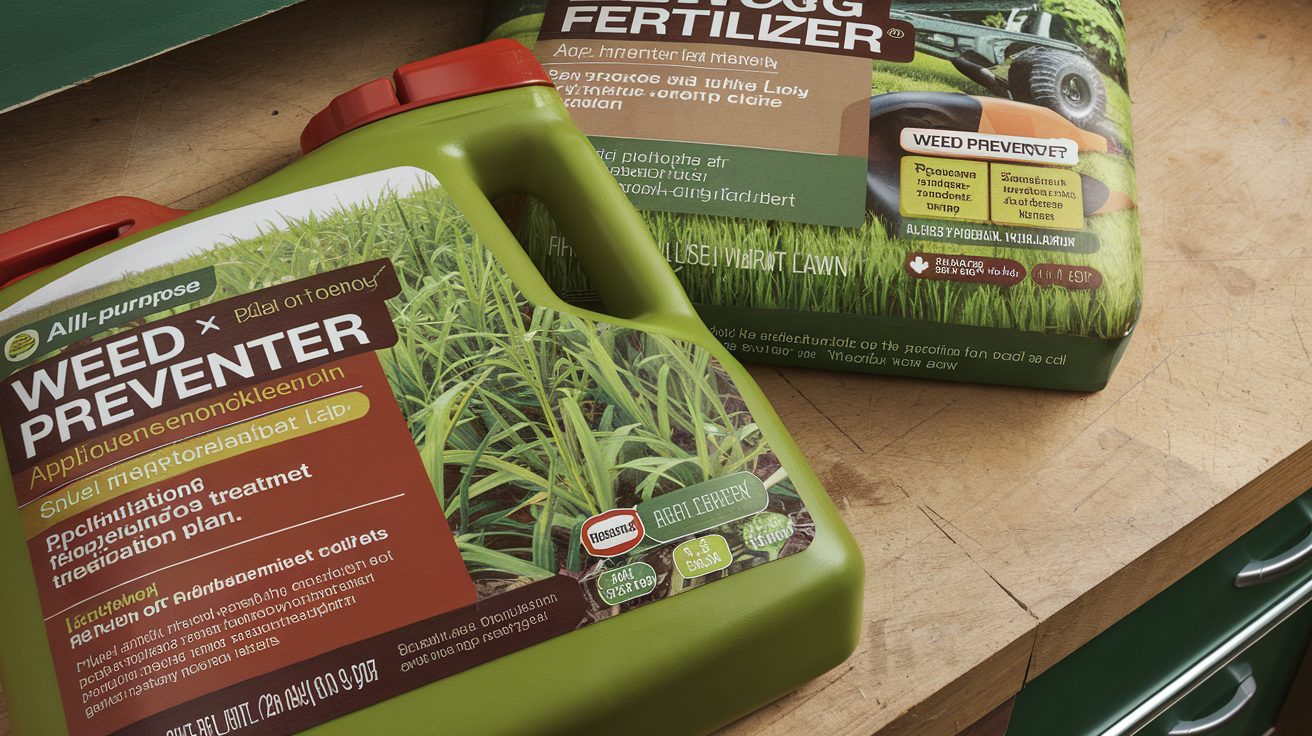Welcome to Rhys Garden‘s comprehensive guide on pre-emergent herbicides and fertilizers – two essential tools in every gardener’s arsenal. Whether you’re a seasoned green thumb or just starting your horticultural journey, understanding these products can make a world of difference in cultivating a lush, thriving garden. Let’s dig in and unearth the secrets to a weed-free, nutrient-rich landscape!
Understanding Pre-Emergent Herbicides
Pre-emergent herbicides are like the vigilant guardians of your garden, working tirelessly beneath the soil’s surface to prevent unwanted weeds from sprouting. But how exactly do they perform this botanical magic?
What Are Pre-Emergent Herbicides?
Pre-emergent herbicides are specialized chemical compounds designed to inhibit seed germination. Unlike post-emergent herbicides that target existing weeds, pre-emergents create a protective barrier in the soil, stopping weed seeds from developing into full-grown plants.
The Science Behind Pre-Emergent Herbicides
These garden defenders work by disrupting cell division in young root tissues. When a weed seed begins to sprout, it encounters the pre-emergent barrier and is unable to establish root systems, effectively halting growth before it even begins.
Timing Is Everything: When to Apply Pre-Emergents
Proper timing is crucial for the effectiveness of pre-emergent herbicides. Generally, they should be applied:
- In early spring before soil temperatures reach 55°F (13°C)
- In late summer or early fall for winter annual weeds
- Before rainfall or irrigation to activate the herbicide
Remember, as the old gardening adage goes, “The early bird catches the worm, but the early gardener catches the weed!”
Types of Pre-Emergent Herbicides
There are several types of pre-emergent herbicides available, each suited to different gardening needs:
- Granular pre-emergents
- Liquid pre-emergents
- Organic pre-emergents
Choosing the Right Pre-Emergent for Your Garden
Selecting the appropriate pre-emergent herbicide depends on various factors:
- Types of weeds common in your area
- Soil type and pH
- Climate and rainfall patterns
- Types of plants in your garden
Always read the label carefully and consult with local gardening experts or extension offices for personalized recommendations.
Fertilizers: Nourishing Your Garden’s Growth

While pre-emergents defend against unwanted growth, fertilizers promote the health and vitality of your desired plants. Let’s explore how these nutrient boosters can transform your garden into a verdant paradise.
The Role of Fertilizers in Plant Health
Fertilizers are like multivitamins for your plants, providing essential nutrients that may be lacking in the soil. They support:
- Stronger root systems
- Lush foliage
- Vibrant blooms
- Increased fruit and vegetable yields
Understanding the N-P-K Ratio
When shopping for fertilizers, you’ll often see three numbers on the package, such as 10-10-10 or 5-10-5. This is the N-P-K ratio, representing:
- N (Nitrogen): Promotes leaf growth and chlorophyll production
- P (Phosphorus): Supports root development and flower formation
- K (Potassium): Enhances overall plant health and disease resistance
Types of Fertilizers
- Organic Fertilizers
- Derived from natural sources
- Release nutrients slowly
- Improve soil structure
- Synthetic Fertilizers
- Manufactured chemically
- Provide quick nutrient release
- Precise nutrient ratios
- Slow-Release Fertilizers
- Deliver nutrients gradually over time
- Reduce the risk of nutrient burn
- Require less frequent application
Choosing the Right Fertilizer for Your Garden
Consider these factors when selecting a fertilizer:
- Soil test results
- Plant species and their specific needs
- Environmental concerns
- Application method preferences
The Synergy of Pre-Emergents and Fertilizers
When used correctly, pre-emergent herbicides and fertilizers can work in harmony to create a thriving, weed-free garden. Here’s how to combine these gardening powerhouses effectively:
Timing Your Applications
- Apply pre-emergent herbicides first, typically in early spring.
- Wait 6-8 weeks before applying fertilizer to allow the pre-emergent barrier to establish.
- Use a gentle, slow-release fertilizer to avoid disrupting the pre-emergent layer.
Watering Considerations
Both pre-emergents and fertilizers require proper watering for activation:
- Water lightly after applying pre-emergents to activate the barrier.
- Water deeply after fertilizing to help nutrients penetrate the soil.
Seasonal Strategies
Spring:
- Apply pre-emergents before soil temperatures reach 55°F (13°C)
- Follow up with a balanced fertilizer once pre-emergent has settled
Summer:
- Reapply pre-emergents if needed (check product instructions)
- Use a high-nitrogen fertilizer for lush growth
Fall:
- Apply pre-emergents for winter annual weeds
- Use a low-nitrogen, high-phosphorus fertilizer to promote root growth
Winter:
- Plan your spring strategy
- Conduct soil tests to prepare for the next growing season
Common Mistakes to Avoid
Even experienced gardeners can sometimes stumble. Here are some pitfalls to watch out for:
- Over-applying pre-emergents or fertilizers
- Disturbing the soil after pre-emergent application
- Ignoring soil pH when choosing fertilizers
- Applying fertilizers to dry soil
- Neglecting to water after application
Organic Alternatives: Nurturing Nature Naturally
For those preferring a more natural approach, there are organic options for both weed prevention and fertilization:
Organic Pre-Emergent Methods
- Corn gluten meal
- Mulching
- Cover crops
- Hand-pulling young weeds
Organic Fertilizers
- Compost
- Bone meal
- Fish emulsion
- Seaweed extracts
The Environmental Impact: Balancing Garden Health and Ecosystem Preservation
While pre-emergents and fertilizers can work wonders for your garden, it’s crucial to consider their environmental impact:
Runoff Concerns
Excessive use of chemicals can lead to water pollution. Mitigate this by:
- Using slow-release formulas
- Avoiding application before heavy rain
- Creating buffer zones near water sources
Soil Health
Long-term chemical use can affect soil microorganisms. Maintain soil health by:
- Rotating between chemical and organic methods
- Regularly adding organic matter to the soil
- Practicing crop rotation in vegetable gardens
Wildlife Considerations
Some products may affect beneficial insects or animals. Protect local wildlife by:
- Choosing pet and wildlife-safe products
- Applying chemicals carefully and according to instructions
- Providing untreated areas as wildlife habitats
Frequently Asked Questions
To address common concerns and queries, here’s a list of frequently asked questions about pre-emergent herbicides and fertilizers:
- Q: Can I seed my lawn after applying pre-emergent herbicides?
A: It’s best to wait until the pre-emergent barrier has broken down, typically 6-8 weeks. Some products may require longer waiting periods. - Q: How often should I fertilize my garden?
A: This depends on the type of plants and fertilizer used. Generally, every 6-8 weeks during the growing season is sufficient for most gardens. - Q: Are pre-emergent herbicides safe for all plants?
A: Not all pre-emergents are safe for all plants. Always check the label for compatibility with your specific plant varieties. - Q: Can I use pre-emergents in my vegetable garden?
A: Some pre-emergents are safe for use in vegetable gardens, but many are not. It’s crucial to choose products specifically labeled for vegetable garden use. - Q: How long do pre-emergent herbicides remain effective?
A: Most pre-emergents provide protection for about 3-4 months, but this can vary based on product and environmental conditions.
Expert Tips for Garden Success
To help you achieve the garden of your dreams, here are some expert tips from the Rhys Garden team:
- Conduct annual soil tests to tailor your fertilizer choices.
- Keep a garden journal to track applications and results.
- Combine cultural practices like proper mowing and watering with chemical treatments for best results.
- Consider using precision applicators for more targeted pre-emergent and fertilizer placement.
- Educate yourself on native plants that naturally resist local weeds and require less fertilization.
Conclusion
Armed with knowledge about pre-emergent herbicides and fertilizers, you’re now ready to transform your outdoor space into a thriving oasis. Remember, gardening is both an art and a science – don’t be afraid to experiment and learn as you grow.
At Rhys Garden, we believe that every patch of earth has the potential to become a beautiful, bountiful garden. By understanding and properly utilizing pre-emergents and fertilizers, you’re well on your way to realizing that potential in your own backyard.
Happy gardening, and may your thumbs always be green!

Related Posts
The Ultimate Guide to Fertilizing For Maple Trees
Unlock the Power of Organic Spent Mushroom Compost
What Fertilizer Is Highest In Nitrogen? Boosting Your Garden’s Green Growth